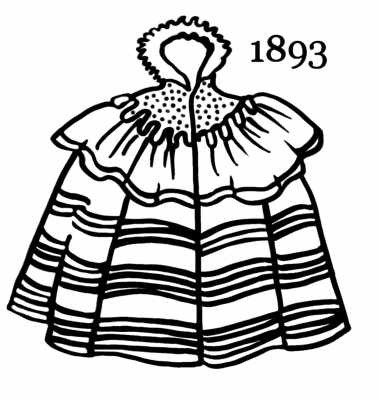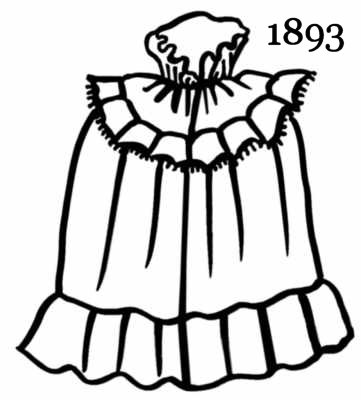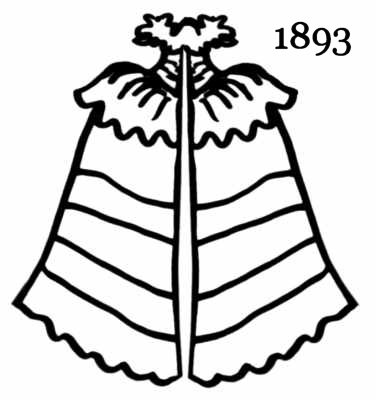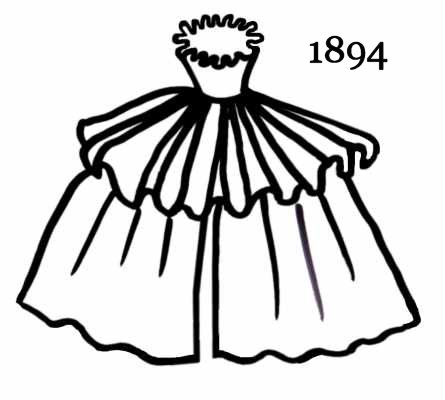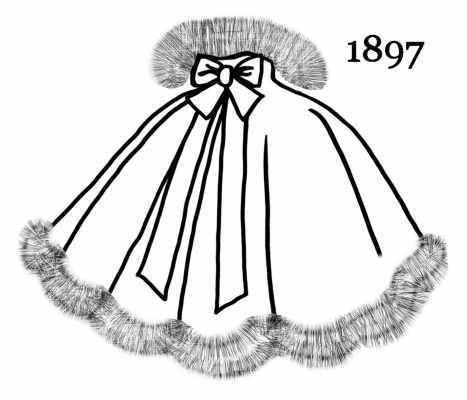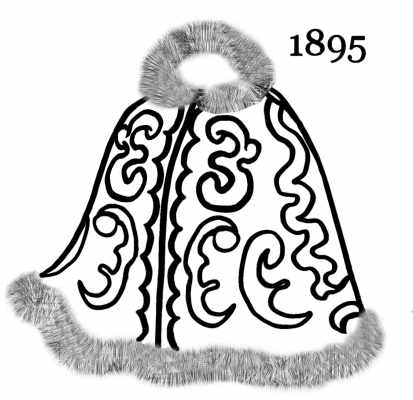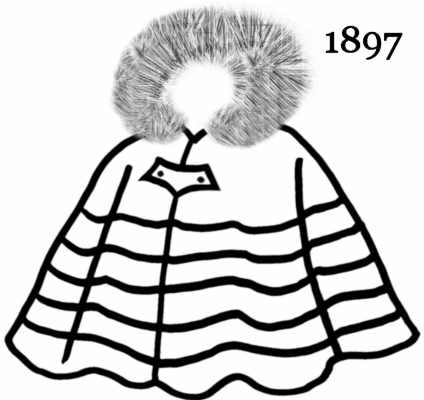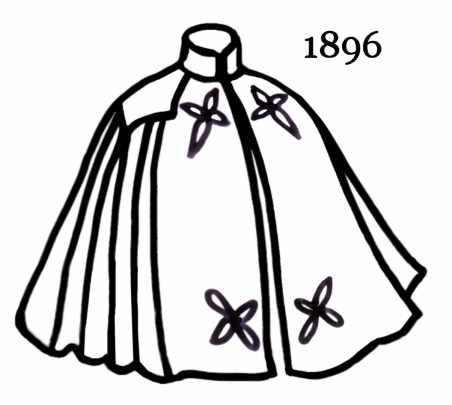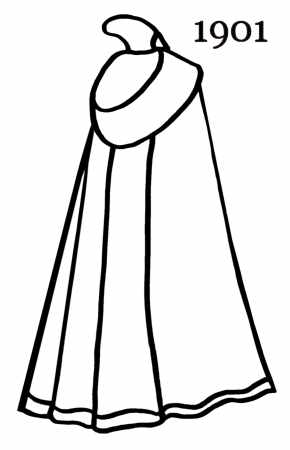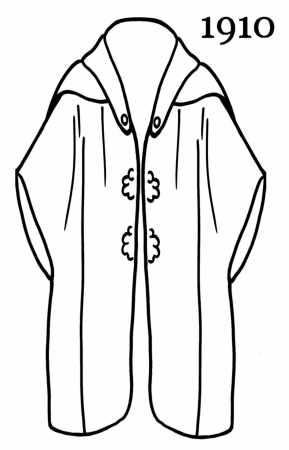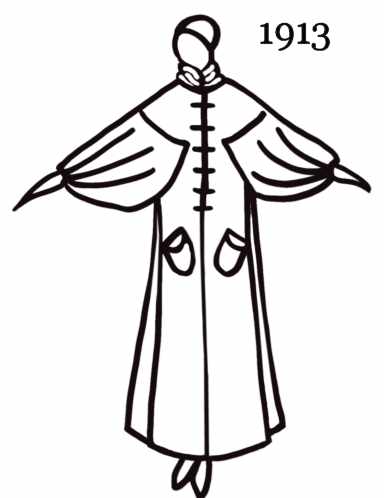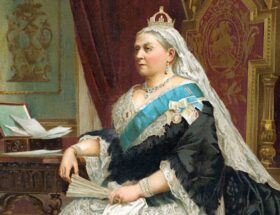By Pauline Weston Thomas for Fashion-Era.com
table of content
- Typical Fancy Fabrics for 1890's Cloaks and Capes
- Tiers and Trimmings on Capes
- Cloak Designs and Fabrics
- Dog Collar Cape Fashions
- Cloaks to Coats 1900 to 1915
Typical Fancy Fabrics for 1890's Cloaks and Capes
The history of fashion would be nothing without fabrics. For cloaks, capes and capelets a wide range of fabrics were used including wool, figured cloth, wool Melton, satin, silk, pleated chiffon, velvet, velveteen, bourdon lace, lace, moiré, taffeta and mourning crepe.
They were trimmed to perfection with passementerie, beading, ribbon, lace, Russia Soutache cord, appliqué, braid and cutwork either all on one garment or focusing on one or two techniques perhaps at the edge or neckline of the cape and maybe around pocket contours.
Tiers and Trimmings on Capes
Cape lengths varied from the short fichu style puritan capes, which barely covered the shoulder line, to full sweeping floor length cloaks. Around the mid 1890s the multi-tiered shoulder cape with high collar was especially fashionable, and high collared styles continued for some years.
Etiquette books advised ladies making up their trousseaus to ensure they had at least 2 or 3 evening wraps (capes) among their purchases.
The short layered shoulder capes of the early to mid 1890s were often made of flimsy materials such as lace and chiffon and bordered on being a capelet or otherwise a fichu pelerine the shorter they were. In the main capes of 1893-4 settled above or on the waist. By 1895 many were just that bit longer at the waist and gaining length.
To illustrate this, the first set of 6 capes I have drawn rest roughly at the waist or even above it and would have been made from lace or lightweight fabrics including layered semi sheers.
Short Layered Edwardian Capes of 1893 and 1894
The second set of 4 capes below with appliqué and fur rest just below the waist and would have been made of cashmere, alpaca and winter weight Melton wool cloths or heavy ribbed or figured silks which were quilted and lined inside, and beautifully fitted with one or two inner secret pockets.
Cloak Designs and Fabrics
Designs were ornate and often followed the curvilinear trailing art nouveau forms seen everywhere at the time. Exquisite embellishment work, such as couched down flora, trailing leaf and curlicue patterns were particularly found on capes. Such cloaks illustrate how the Edwardians had reached the pinnacle of the art of high living through the clothing worn by the Edwardian lady, who was regarded as a social representative of her husband.
All capes and cloaks could be trimmed with fur like Russian sable or feathers. Fabric trims such as ruched chiffon, moiré or velvet and ornate macramé fringe were all used to create variety and add interest to a very basic shape. All could be lined with self colour or contrast silk or quilted with a batted lining and all usually had a small secret inner pocket for a lady’s items. The cosy linings protected pampered Edwardians from the cooler elements.
Appliqué, braid and cutwork were especially popular combinations with fur trim as the contrast of textures created a great deal of garment interest.
Dog Collar Cape Fashions
From 1895 collars on capes became higher and higher and by 1900 collars matched the very high dog collar styles on dresses and blouses. They often combined elements from the 1890s with chiffon pleat trims and appliqué.
Heavy jet passementerie on mourning capes was very popular, particularly in the secondary mourning period when embellishment could be tastefully added.
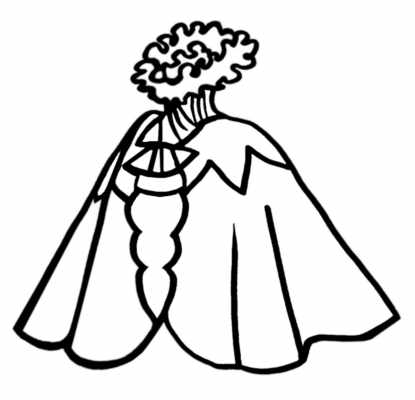
Cloak vs Coat 1900 to 1915
Until 1910 full length cloaks and capes were still worn, but after that date became rarer by day and many women favoured wearing a coat. Mainly older women wore cloaks after 1900 and it became a mature fashion.
However as mature women were the fashion leaders it was usual to see some variety of styles between a coat which was full length or just below the knee and showing visible skirt or similar length cloaks. Women who still adored the opulence of cloaks continued to have them made in luxurious fabrics trimmed with furs like ermine.
Between 1900 and 1914 a huge variety of coat styles could be bought. Loose dust coats (dusters) for car use and intended to cover a wide range of outfits were ever a popular choice for the elite. Straighter coats became usual 1910-14 and they had low shawl type collars to the first fastening.
The new oriental style cocoon coats also helped the demise of capes as the all enveloping nature of the cocoon coat fulfilled a similar function that the cape or cloak had previously. Likewise, innovative styles from new thinking designers used elements of the cape to create new coat styles similar to the one sketched above after a 1913 Era fashion drawing.
The cape in the header is circa 1916 and despite the fact that capes were less worn then, this one is particularly pert and attractive and would have balanced the full skirted shorter length crinoline of the inter war years perfectly.
Longer Capes that Merged into Coat Styles
This is an original content by Pauline Weston Thomas for Fashion-Era.com
